Analyzing Assessment Methods: Unit 305, Level 3 Education Award
VerifiedAdded on 2023/01/03
|10
|2266
|1
Homework Assignment
AI Summary
This assignment delves into various assessment methods crucial for educators, focusing on Unit 305 of the Level 3 Award in Education and Training. It begins by defining key features of initial, formative, and summative assessments. The assignment emphasizes the importance of involving learners and others in the assessment process, highlighting the benefits of self and peer assessment. It lists and describes different assessment methods, such as assignments, discussions, case studies, and exams. The document compares the strengths and limitations of these methods in meeting individual learner needs and suggests how to adapt them effectively. The assignment also explains the role of constructive feedback, outlining its features and contribution to the assessment process, including how to deliver it effectively. Finally, it specifies the information sources that should be made available to learners and the records that should be kept, along with organizational requirements.
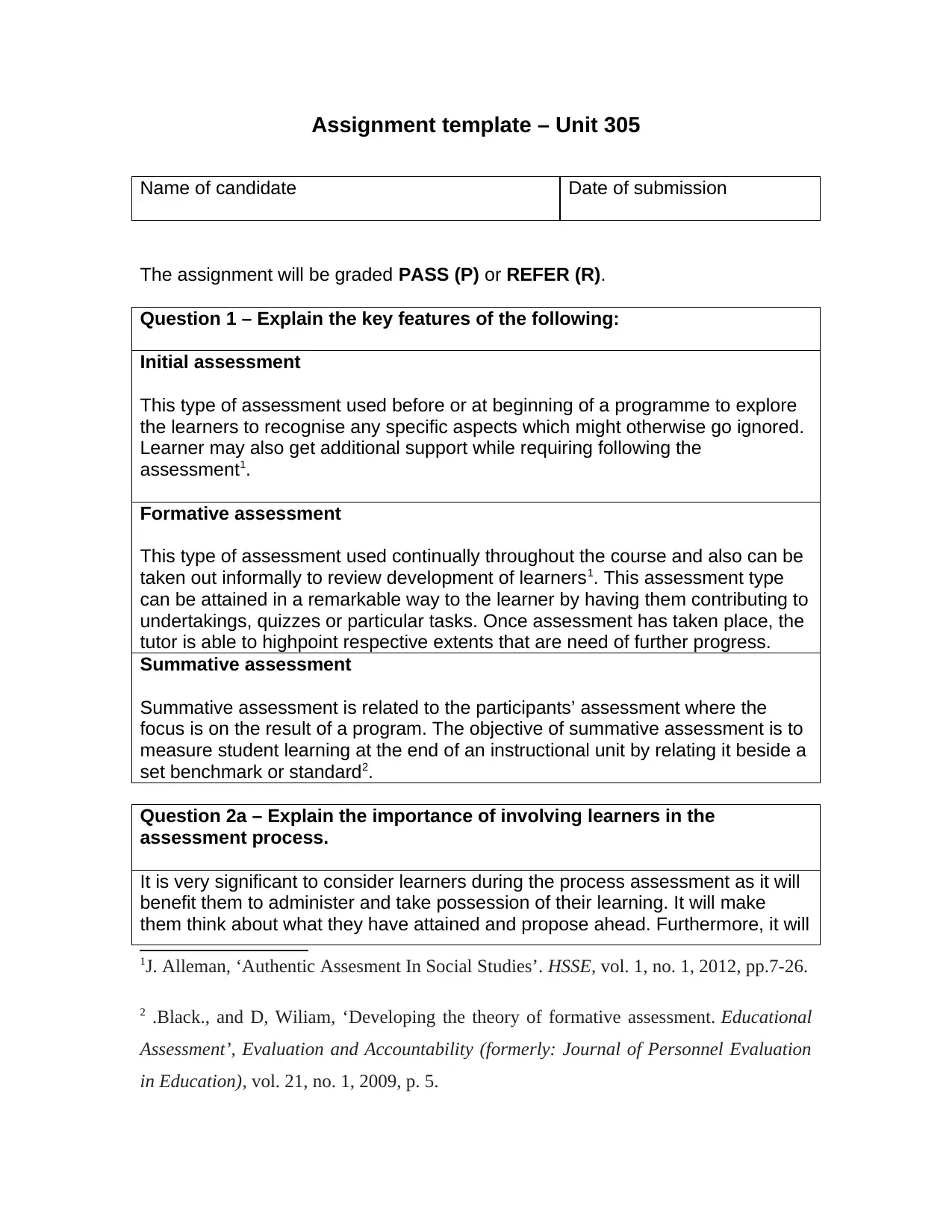
Assignment template – Unit 305
Name of candidate Date of submission
The assignment will be graded PASS (P) or REFER (R).
Question 1 – Explain the key features of the following:
Initial assessment
This type of assessment used before or at beginning of a programme to explore
the learners to recognise any specific aspects which might otherwise go ignored.
Learner may also get additional support while requiring following the
assessment1.
Formative assessment
This type of assessment used continually throughout the course and also can be
taken out informally to review development of learners1. This assessment type
can be attained in a remarkable way to the learner by having them contributing to
undertakings, quizzes or particular tasks. Once assessment has taken place, the
tutor is able to highpoint respective extents that are need of further progress.
Summative assessment
Summative assessment is related to the participants’ assessment where the
focus is on the result of a program. The objective of summative assessment is to
measure student learning at the end of an instructional unit by relating it beside a
set benchmark or standard2.
Question 2a – Explain the importance of involving learners in the
assessment process.
It is very significant to consider learners during the process assessment as it will
benefit them to administer and take possession of their learning. It will make
them think about what they have attained and propose ahead. Furthermore, it will
1J. Alleman, ‘Authentic Assesment In Social Studies’. HSSE, vol. 1, no. 1, 2012, pp.7-26.
2 .Black., and D, Wiliam, ‘Developing the theory of formative assessment. Educational
Assessment’, Evaluation and Accountability (formerly: Journal of Personnel Evaluation
in Education), vol. 21, no. 1, 2009, p. 5.
Name of candidate Date of submission
The assignment will be graded PASS (P) or REFER (R).
Question 1 – Explain the key features of the following:
Initial assessment
This type of assessment used before or at beginning of a programme to explore
the learners to recognise any specific aspects which might otherwise go ignored.
Learner may also get additional support while requiring following the
assessment1.
Formative assessment
This type of assessment used continually throughout the course and also can be
taken out informally to review development of learners1. This assessment type
can be attained in a remarkable way to the learner by having them contributing to
undertakings, quizzes or particular tasks. Once assessment has taken place, the
tutor is able to highpoint respective extents that are need of further progress.
Summative assessment
Summative assessment is related to the participants’ assessment where the
focus is on the result of a program. The objective of summative assessment is to
measure student learning at the end of an instructional unit by relating it beside a
set benchmark or standard2.
Question 2a – Explain the importance of involving learners in the
assessment process.
It is very significant to consider learners during the process assessment as it will
benefit them to administer and take possession of their learning. It will make
them think about what they have attained and propose ahead. Furthermore, it will
1J. Alleman, ‘Authentic Assesment In Social Studies’. HSSE, vol. 1, no. 1, 2012, pp.7-26.
2 .Black., and D, Wiliam, ‘Developing the theory of formative assessment. Educational
Assessment’, Evaluation and Accountability (formerly: Journal of Personnel Evaluation
in Education), vol. 21, no. 1, 2009, p. 5.
Paraphrase This Document
Need a fresh take? Get an instant paraphrase of this document with our AI Paraphraser
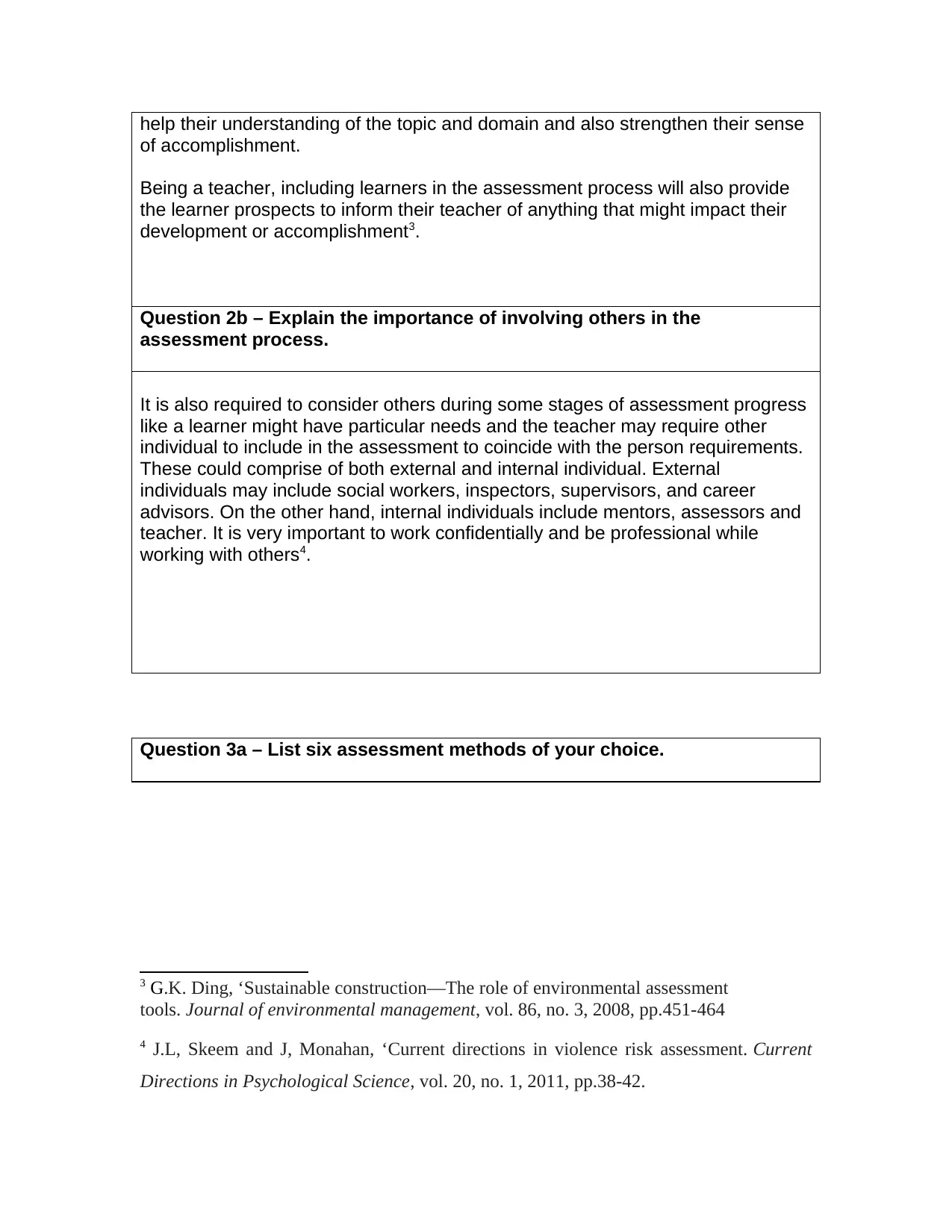
help their understanding of the topic and domain and also strengthen their sense
of accomplishment.
Being a teacher, including learners in the assessment process will also provide
the learner prospects to inform their teacher of anything that might impact their
development or accomplishment3.
Question 2b – Explain the importance of involving others in the
assessment process.
It is also required to consider others during some stages of assessment progress
like a learner might have particular needs and the teacher may require other
individual to include in the assessment to coincide with the person requirements.
These could comprise of both external and internal individual. External
individuals may include social workers, inspectors, supervisors, and career
advisors. On the other hand, internal individuals include mentors, assessors and
teacher. It is very important to work confidentially and be professional while
working with others4.
Question 3a – List six assessment methods of your choice.
3 G.K. Ding, ‘Sustainable construction—The role of environmental assessment
tools. Journal of environmental management, vol. 86, no. 3, 2008, pp.451-464
4 J.L, Skeem and J, Monahan, ‘Current directions in violence risk assessment. Current
Directions in Psychological Science, vol. 20, no. 1, 2011, pp.38-42.
of accomplishment.
Being a teacher, including learners in the assessment process will also provide
the learner prospects to inform their teacher of anything that might impact their
development or accomplishment3.
Question 2b – Explain the importance of involving others in the
assessment process.
It is also required to consider others during some stages of assessment progress
like a learner might have particular needs and the teacher may require other
individual to include in the assessment to coincide with the person requirements.
These could comprise of both external and internal individual. External
individuals may include social workers, inspectors, supervisors, and career
advisors. On the other hand, internal individuals include mentors, assessors and
teacher. It is very important to work confidentially and be professional while
working with others4.
Question 3a – List six assessment methods of your choice.
3 G.K. Ding, ‘Sustainable construction—The role of environmental assessment
tools. Journal of environmental management, vol. 86, no. 3, 2008, pp.451-464
4 J.L, Skeem and J, Monahan, ‘Current directions in violence risk assessment. Current
Directions in Psychological Science, vol. 20, no. 1, 2011, pp.38-42.
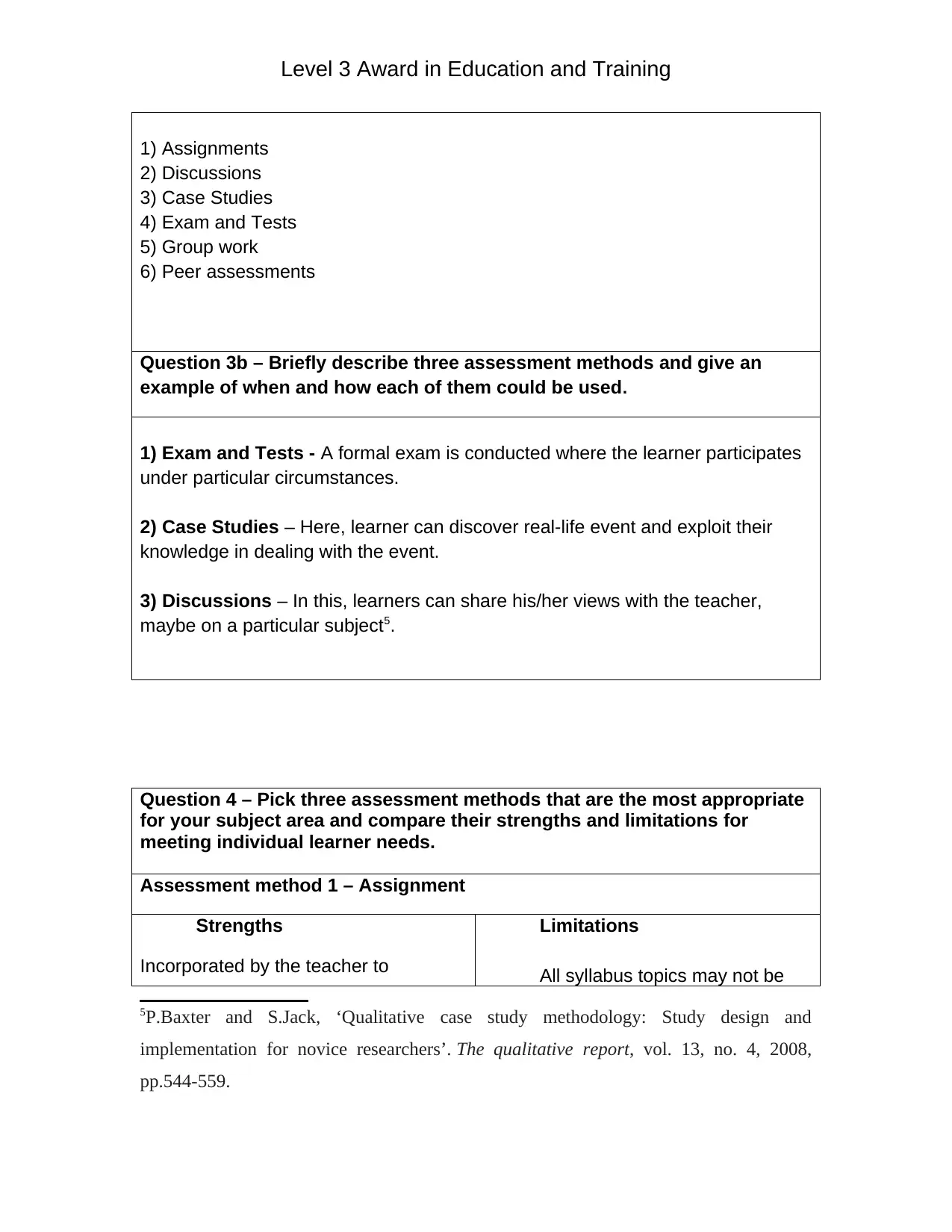
Level 3 Award in Education and Training
1) Assignments
2) Discussions
3) Case Studies
4) Exam and Tests
5) Group work
6) Peer assessments
Question 3b – Briefly describe three assessment methods and give an
example of when and how each of them could be used.
1) Exam and Tests - A formal exam is conducted where the learner participates
under particular circumstances.
2) Case Studies – Here, learner can discover real-life event and exploit their
knowledge in dealing with the event.
3) Discussions – In this, learners can share his/her views with the teacher,
maybe on a particular subject5.
Question 4 – Pick three assessment methods that are the most appropriate
for your subject area and compare their strengths and limitations for
meeting individual learner needs.
Assessment method 1 – Assignment
Strengths
Incorporated by the teacher to
Limitations
All syllabus topics may not be
5P.Baxter and S.Jack, ‘Qualitative case study methodology: Study design and
implementation for novice researchers’. The qualitative report, vol. 13, no. 4, 2008,
pp.544-559.
1) Assignments
2) Discussions
3) Case Studies
4) Exam and Tests
5) Group work
6) Peer assessments
Question 3b – Briefly describe three assessment methods and give an
example of when and how each of them could be used.
1) Exam and Tests - A formal exam is conducted where the learner participates
under particular circumstances.
2) Case Studies – Here, learner can discover real-life event and exploit their
knowledge in dealing with the event.
3) Discussions – In this, learners can share his/her views with the teacher,
maybe on a particular subject5.
Question 4 – Pick three assessment methods that are the most appropriate
for your subject area and compare their strengths and limitations for
meeting individual learner needs.
Assessment method 1 – Assignment
Strengths
Incorporated by the teacher to
Limitations
All syllabus topics may not be
5P.Baxter and S.Jack, ‘Qualitative case study methodology: Study design and
implementation for novice researchers’. The qualitative report, vol. 13, no. 4, 2008,
pp.544-559.
⊘ This is a preview!⊘
Do you want full access?
Subscribe today to unlock all pages.

Trusted by 1+ million students worldwide
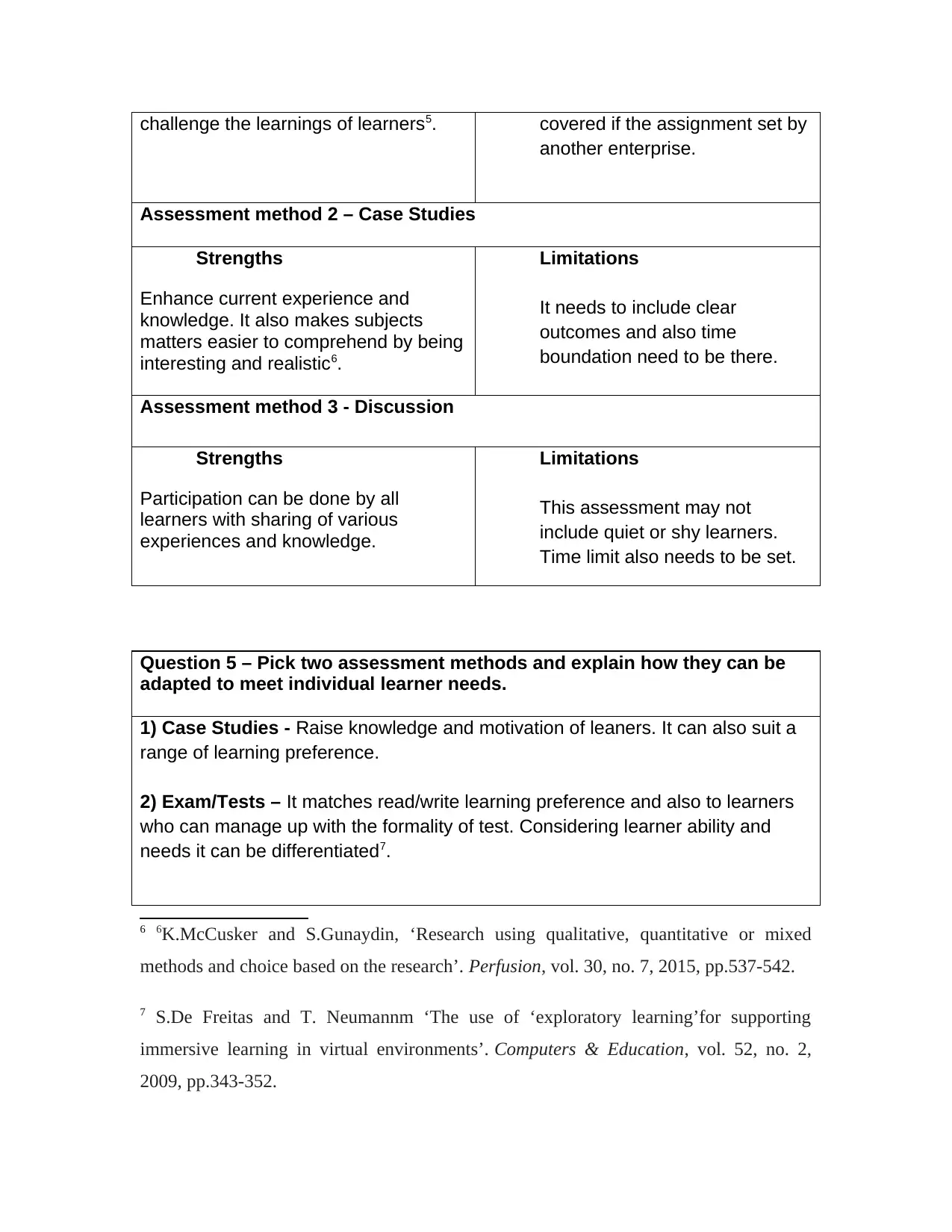
challenge the learnings of learners5. covered if the assignment set by
another enterprise.
Assessment method 2 – Case Studies
Strengths
Enhance current experience and
knowledge. It also makes subjects
matters easier to comprehend by being
interesting and realistic6.
Limitations
It needs to include clear
outcomes and also time
boundation need to be there.
Assessment method 3 - Discussion
Strengths
Participation can be done by all
learners with sharing of various
experiences and knowledge.
Limitations
This assessment may not
include quiet or shy learners.
Time limit also needs to be set.
Question 5 – Pick two assessment methods and explain how they can be
adapted to meet individual learner needs.
1) Case Studies - Raise knowledge and motivation of leaners. It can also suit a
range of learning preference.
2) Exam/Tests – It matches read/write learning preference and also to learners
who can manage up with the formality of test. Considering learner ability and
needs it can be differentiated7.
6 6K.McCusker and S.Gunaydin, ‘Research using qualitative, quantitative or mixed
methods and choice based on the research’. Perfusion, vol. 30, no. 7, 2015, pp.537-542.
7 S.De Freitas and T. Neumannm ‘The use of ‘exploratory learning’for supporting
immersive learning in virtual environments’. Computers & Education, vol. 52, no. 2,
2009, pp.343-352.
another enterprise.
Assessment method 2 – Case Studies
Strengths
Enhance current experience and
knowledge. It also makes subjects
matters easier to comprehend by being
interesting and realistic6.
Limitations
It needs to include clear
outcomes and also time
boundation need to be there.
Assessment method 3 - Discussion
Strengths
Participation can be done by all
learners with sharing of various
experiences and knowledge.
Limitations
This assessment may not
include quiet or shy learners.
Time limit also needs to be set.
Question 5 – Pick two assessment methods and explain how they can be
adapted to meet individual learner needs.
1) Case Studies - Raise knowledge and motivation of leaners. It can also suit a
range of learning preference.
2) Exam/Tests – It matches read/write learning preference and also to learners
who can manage up with the formality of test. Considering learner ability and
needs it can be differentiated7.
6 6K.McCusker and S.Gunaydin, ‘Research using qualitative, quantitative or mixed
methods and choice based on the research’. Perfusion, vol. 30, no. 7, 2015, pp.537-542.
7 S.De Freitas and T. Neumannm ‘The use of ‘exploratory learning’for supporting
immersive learning in virtual environments’. Computers & Education, vol. 52, no. 2,
2009, pp.343-352.
Paraphrase This Document
Need a fresh take? Get an instant paraphrase of this document with our AI Paraphraser
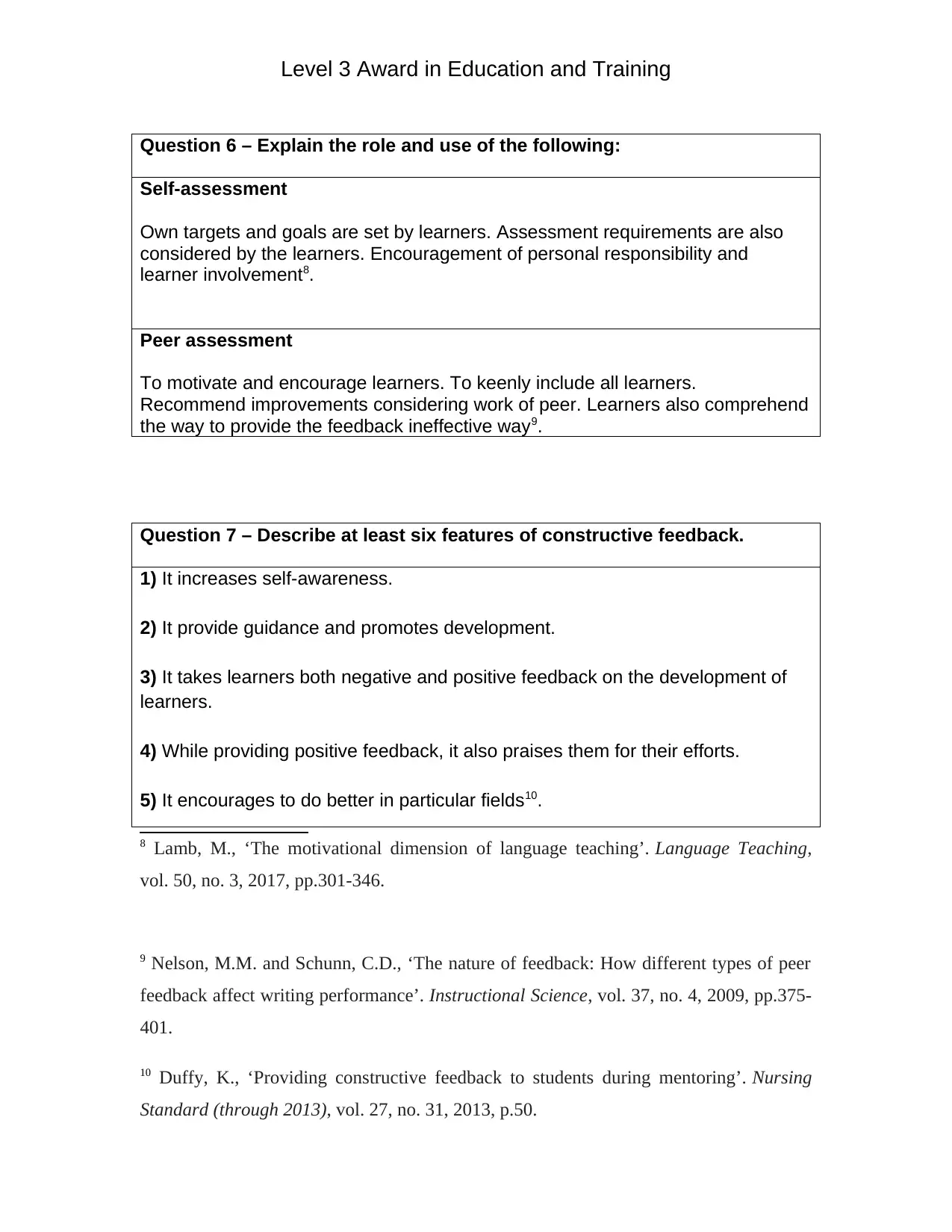
Level 3 Award in Education and Training
Question 6 – Explain the role and use of the following:
Self-assessment
Own targets and goals are set by learners. Assessment requirements are also
considered by the learners. Encouragement of personal responsibility and
learner involvement8.
Peer assessment
To motivate and encourage learners. To keenly include all learners.
Recommend improvements considering work of peer. Learners also comprehend
the way to provide the feedback ineffective way9.
Question 7 – Describe at least six features of constructive feedback.
1) It increases self-awareness.
2) It provide guidance and promotes development.
3) It takes learners both negative and positive feedback on the development of
learners.
4) While providing positive feedback, it also praises them for their efforts.
5) It encourages to do better in particular fields10.
8 Lamb, M., ‘The motivational dimension of language teaching’. Language Teaching,
vol. 50, no. 3, 2017, pp.301-346.
9 Nelson, M.M. and Schunn, C.D., ‘The nature of feedback: How different types of peer
feedback affect writing performance’. Instructional Science, vol. 37, no. 4, 2009, pp.375-
401.
10 Duffy, K., ‘Providing constructive feedback to students during mentoring’. Nursing
Standard (through 2013), vol. 27, no. 31, 2013, p.50.
Question 6 – Explain the role and use of the following:
Self-assessment
Own targets and goals are set by learners. Assessment requirements are also
considered by the learners. Encouragement of personal responsibility and
learner involvement8.
Peer assessment
To motivate and encourage learners. To keenly include all learners.
Recommend improvements considering work of peer. Learners also comprehend
the way to provide the feedback ineffective way9.
Question 7 – Describe at least six features of constructive feedback.
1) It increases self-awareness.
2) It provide guidance and promotes development.
3) It takes learners both negative and positive feedback on the development of
learners.
4) While providing positive feedback, it also praises them for their efforts.
5) It encourages to do better in particular fields10.
8 Lamb, M., ‘The motivational dimension of language teaching’. Language Teaching,
vol. 50, no. 3, 2017, pp.301-346.
9 Nelson, M.M. and Schunn, C.D., ‘The nature of feedback: How different types of peer
feedback affect writing performance’. Instructional Science, vol. 37, no. 4, 2009, pp.375-
401.
10 Duffy, K., ‘Providing constructive feedback to students during mentoring’. Nursing
Standard (through 2013), vol. 27, no. 31, 2013, p.50.
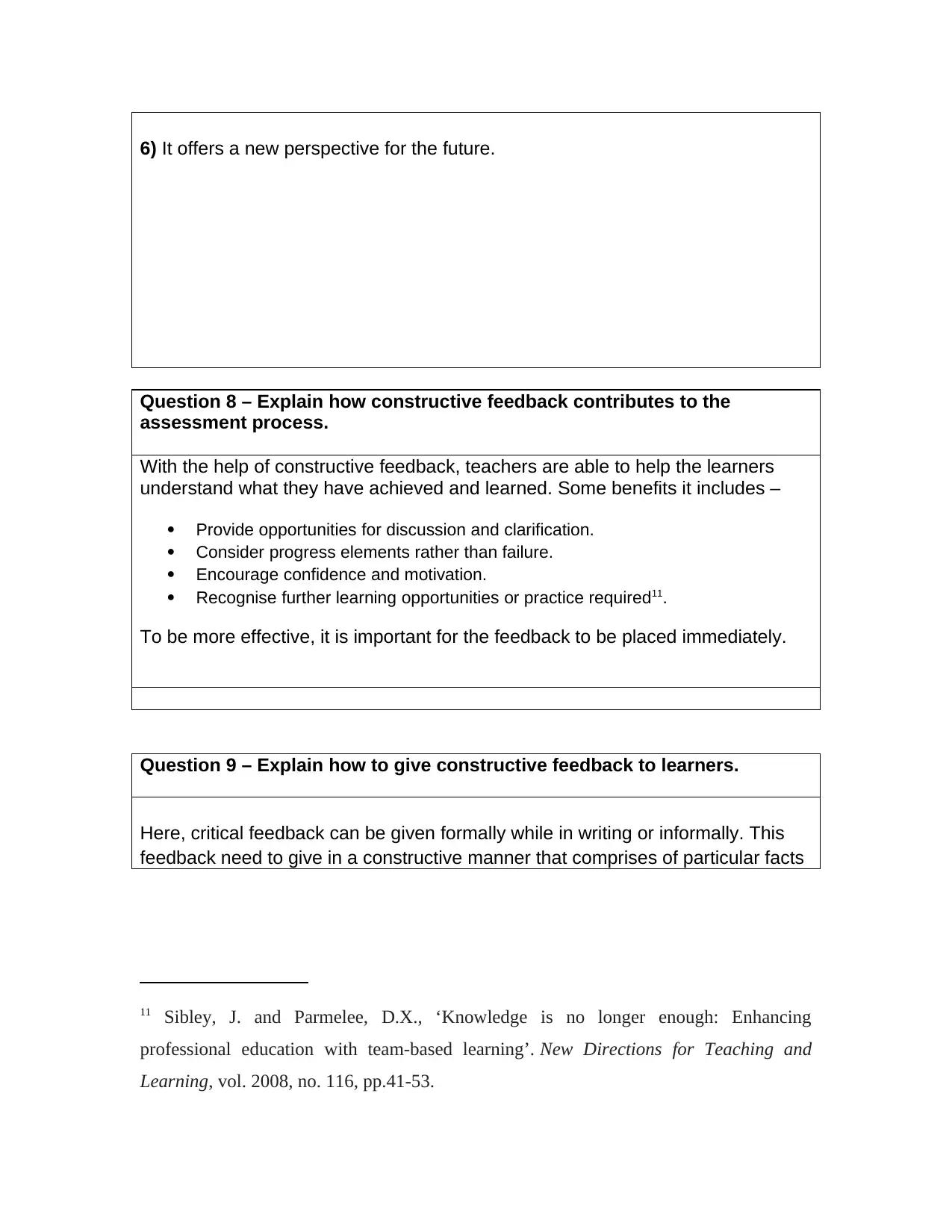
6) It offers a new perspective for the future.
Question 8 – Explain how constructive feedback contributes to the
assessment process.
With the help of constructive feedback, teachers are able to help the learners
understand what they have achieved and learned. Some benefits it includes –
Provide opportunities for discussion and clarification.
Consider progress elements rather than failure.
Encourage confidence and motivation.
Recognise further learning opportunities or practice required11.
To be more effective, it is important for the feedback to be placed immediately.
Question 9 – Explain how to give constructive feedback to learners.
Here, critical feedback can be given formally while in writing or informally. This
feedback need to give in a constructive manner that comprises of particular facts
11 Sibley, J. and Parmelee, D.X., ‘Knowledge is no longer enough: Enhancing
professional education with team‐based learning’. New Directions for Teaching and
Learning, vol. 2008, no. 116, pp.41-53.
Question 8 – Explain how constructive feedback contributes to the
assessment process.
With the help of constructive feedback, teachers are able to help the learners
understand what they have achieved and learned. Some benefits it includes –
Provide opportunities for discussion and clarification.
Consider progress elements rather than failure.
Encourage confidence and motivation.
Recognise further learning opportunities or practice required11.
To be more effective, it is important for the feedback to be placed immediately.
Question 9 – Explain how to give constructive feedback to learners.
Here, critical feedback can be given formally while in writing or informally. This
feedback need to give in a constructive manner that comprises of particular facts
11 Sibley, J. and Parmelee, D.X., ‘Knowledge is no longer enough: Enhancing
professional education with team‐based learning’. New Directions for Teaching and
Learning, vol. 2008, no. 116, pp.41-53.
⊘ This is a preview!⊘
Do you want full access?
Subscribe today to unlock all pages.

Trusted by 1+ million students worldwide
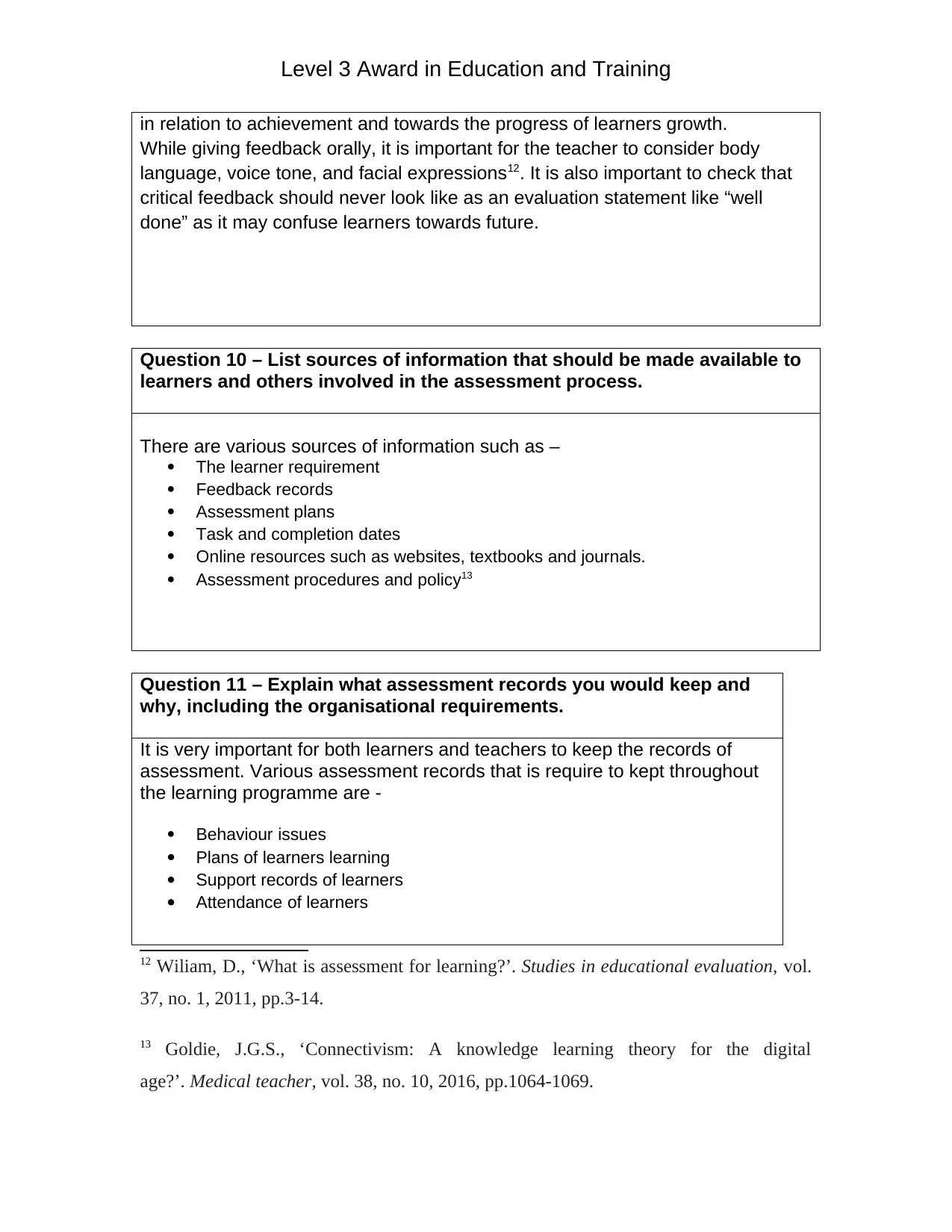
Level 3 Award in Education and Training
in relation to achievement and towards the progress of learners growth.
While giving feedback orally, it is important for the teacher to consider body
language, voice tone, and facial expressions12. It is also important to check that
critical feedback should never look like as an evaluation statement like “well
done” as it may confuse learners towards future.
Question 10 – List sources of information that should be made available to
learners and others involved in the assessment process.
There are various sources of information such as –
The learner requirement
Feedback records
Assessment plans
Task and completion dates
Online resources such as websites, textbooks and journals.
Assessment procedures and policy13
Question 11 – Explain what assessment records you would keep and
why, including the organisational requirements.
It is very important for both learners and teachers to keep the records of
assessment. Various assessment records that is require to kept throughout
the learning programme are -
Behaviour issues
Plans of learners learning
Support records of learners
Attendance of learners
12 Wiliam, D., ‘What is assessment for learning?’. Studies in educational evaluation, vol.
37, no. 1, 2011, pp.3-14.
13 Goldie, J.G.S., ‘Connectivism: A knowledge learning theory for the digital
age?’. Medical teacher, vol. 38, no. 10, 2016, pp.1064-1069.
in relation to achievement and towards the progress of learners growth.
While giving feedback orally, it is important for the teacher to consider body
language, voice tone, and facial expressions12. It is also important to check that
critical feedback should never look like as an evaluation statement like “well
done” as it may confuse learners towards future.
Question 10 – List sources of information that should be made available to
learners and others involved in the assessment process.
There are various sources of information such as –
The learner requirement
Feedback records
Assessment plans
Task and completion dates
Online resources such as websites, textbooks and journals.
Assessment procedures and policy13
Question 11 – Explain what assessment records you would keep and
why, including the organisational requirements.
It is very important for both learners and teachers to keep the records of
assessment. Various assessment records that is require to kept throughout
the learning programme are -
Behaviour issues
Plans of learners learning
Support records of learners
Attendance of learners
12 Wiliam, D., ‘What is assessment for learning?’. Studies in educational evaluation, vol.
37, no. 1, 2011, pp.3-14.
13 Goldie, J.G.S., ‘Connectivism: A knowledge learning theory for the digital
age?’. Medical teacher, vol. 38, no. 10, 2016, pp.1064-1069.
Paraphrase This Document
Need a fresh take? Get an instant paraphrase of this document with our AI Paraphraser
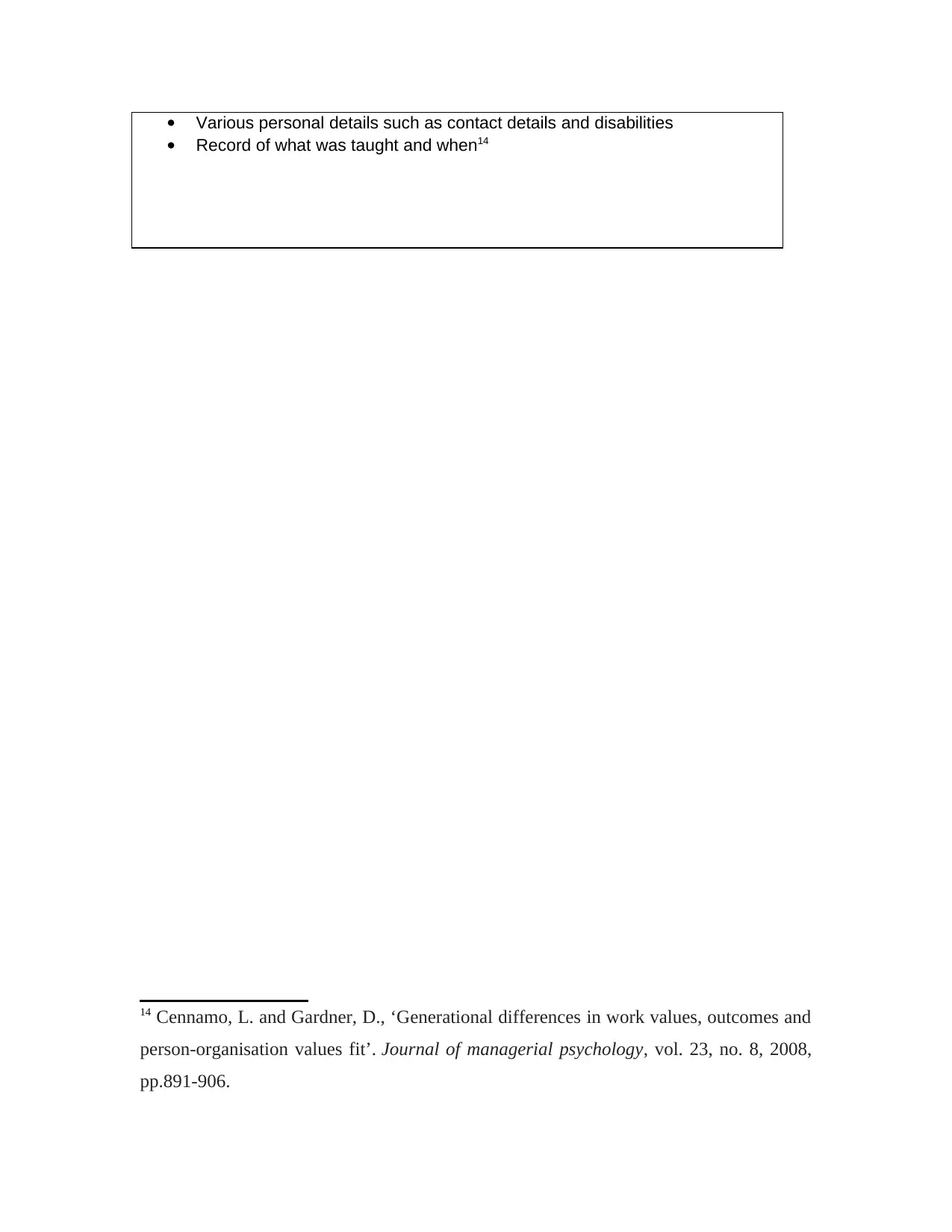
Various personal details such as contact details and disabilities
Record of what was taught and when14
14 Cennamo, L. and Gardner, D., ‘Generational differences in work values, outcomes and
person-organisation values fit’. Journal of managerial psychology, vol. 23, no. 8, 2008,
pp.891-906.
Record of what was taught and when14
14 Cennamo, L. and Gardner, D., ‘Generational differences in work values, outcomes and
person-organisation values fit’. Journal of managerial psychology, vol. 23, no. 8, 2008,
pp.891-906.
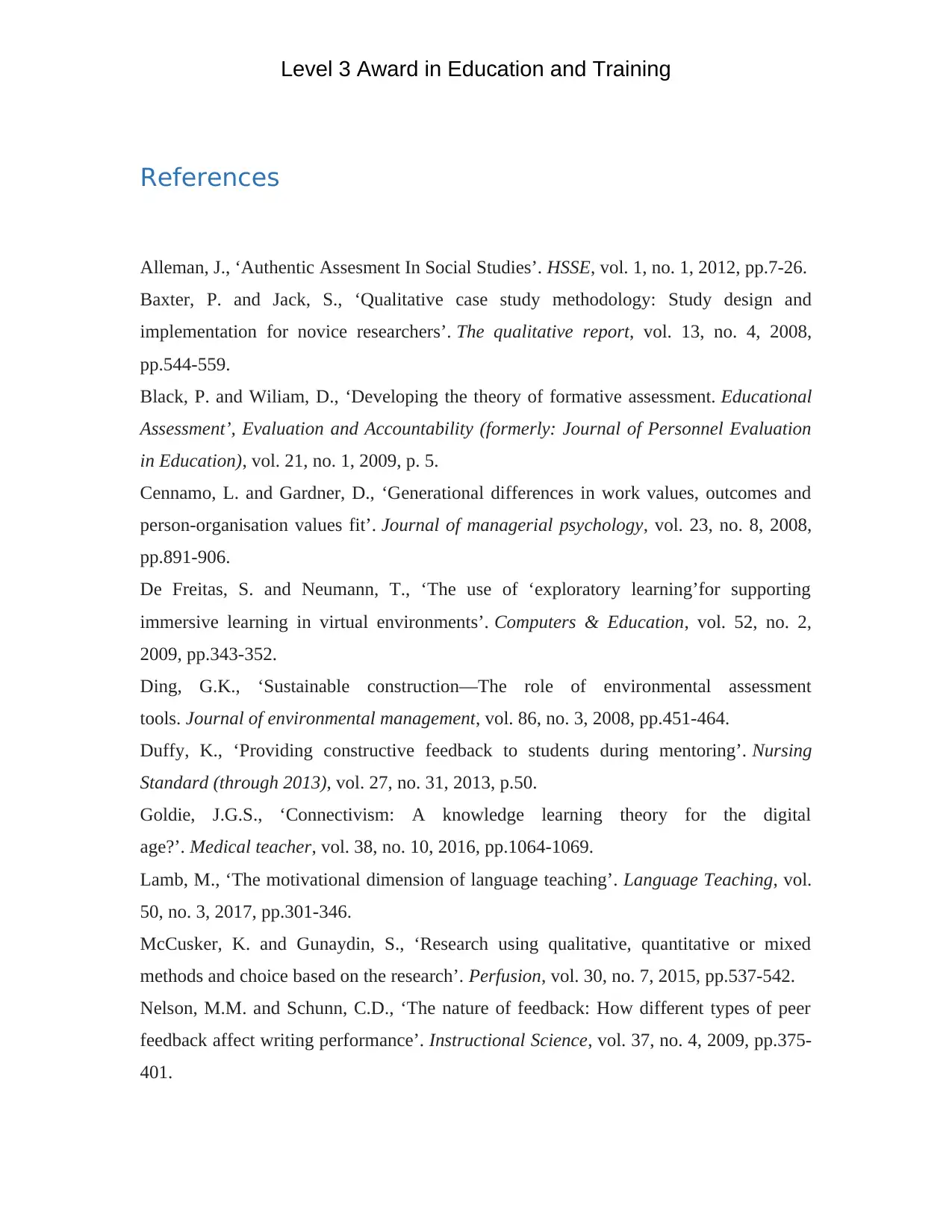
Level 3 Award in Education and Training
References
Alleman, J., ‘Authentic Assesment In Social Studies’. HSSE, vol. 1, no. 1, 2012, pp.7-26.
Baxter, P. and Jack, S., ‘Qualitative case study methodology: Study design and
implementation for novice researchers’. The qualitative report, vol. 13, no. 4, 2008,
pp.544-559.
Black, P. and Wiliam, D., ‘Developing the theory of formative assessment. Educational
Assessment’, Evaluation and Accountability (formerly: Journal of Personnel Evaluation
in Education), vol. 21, no. 1, 2009, p. 5.
Cennamo, L. and Gardner, D., ‘Generational differences in work values, outcomes and
person-organisation values fit’. Journal of managerial psychology, vol. 23, no. 8, 2008,
pp.891-906.
De Freitas, S. and Neumann, T., ‘The use of ‘exploratory learning’for supporting
immersive learning in virtual environments’. Computers & Education, vol. 52, no. 2,
2009, pp.343-352.
Ding, G.K., ‘Sustainable construction—The role of environmental assessment
tools. Journal of environmental management, vol. 86, no. 3, 2008, pp.451-464.
Duffy, K., ‘Providing constructive feedback to students during mentoring’. Nursing
Standard (through 2013), vol. 27, no. 31, 2013, p.50.
Goldie, J.G.S., ‘Connectivism: A knowledge learning theory for the digital
age?’. Medical teacher, vol. 38, no. 10, 2016, pp.1064-1069.
Lamb, M., ‘The motivational dimension of language teaching’. Language Teaching, vol.
50, no. 3, 2017, pp.301-346.
McCusker, K. and Gunaydin, S., ‘Research using qualitative, quantitative or mixed
methods and choice based on the research’. Perfusion, vol. 30, no. 7, 2015, pp.537-542.
Nelson, M.M. and Schunn, C.D., ‘The nature of feedback: How different types of peer
feedback affect writing performance’. Instructional Science, vol. 37, no. 4, 2009, pp.375-
401.
References
Alleman, J., ‘Authentic Assesment In Social Studies’. HSSE, vol. 1, no. 1, 2012, pp.7-26.
Baxter, P. and Jack, S., ‘Qualitative case study methodology: Study design and
implementation for novice researchers’. The qualitative report, vol. 13, no. 4, 2008,
pp.544-559.
Black, P. and Wiliam, D., ‘Developing the theory of formative assessment. Educational
Assessment’, Evaluation and Accountability (formerly: Journal of Personnel Evaluation
in Education), vol. 21, no. 1, 2009, p. 5.
Cennamo, L. and Gardner, D., ‘Generational differences in work values, outcomes and
person-organisation values fit’. Journal of managerial psychology, vol. 23, no. 8, 2008,
pp.891-906.
De Freitas, S. and Neumann, T., ‘The use of ‘exploratory learning’for supporting
immersive learning in virtual environments’. Computers & Education, vol. 52, no. 2,
2009, pp.343-352.
Ding, G.K., ‘Sustainable construction—The role of environmental assessment
tools. Journal of environmental management, vol. 86, no. 3, 2008, pp.451-464.
Duffy, K., ‘Providing constructive feedback to students during mentoring’. Nursing
Standard (through 2013), vol. 27, no. 31, 2013, p.50.
Goldie, J.G.S., ‘Connectivism: A knowledge learning theory for the digital
age?’. Medical teacher, vol. 38, no. 10, 2016, pp.1064-1069.
Lamb, M., ‘The motivational dimension of language teaching’. Language Teaching, vol.
50, no. 3, 2017, pp.301-346.
McCusker, K. and Gunaydin, S., ‘Research using qualitative, quantitative or mixed
methods and choice based on the research’. Perfusion, vol. 30, no. 7, 2015, pp.537-542.
Nelson, M.M. and Schunn, C.D., ‘The nature of feedback: How different types of peer
feedback affect writing performance’. Instructional Science, vol. 37, no. 4, 2009, pp.375-
401.
⊘ This is a preview!⊘
Do you want full access?
Subscribe today to unlock all pages.

Trusted by 1+ million students worldwide
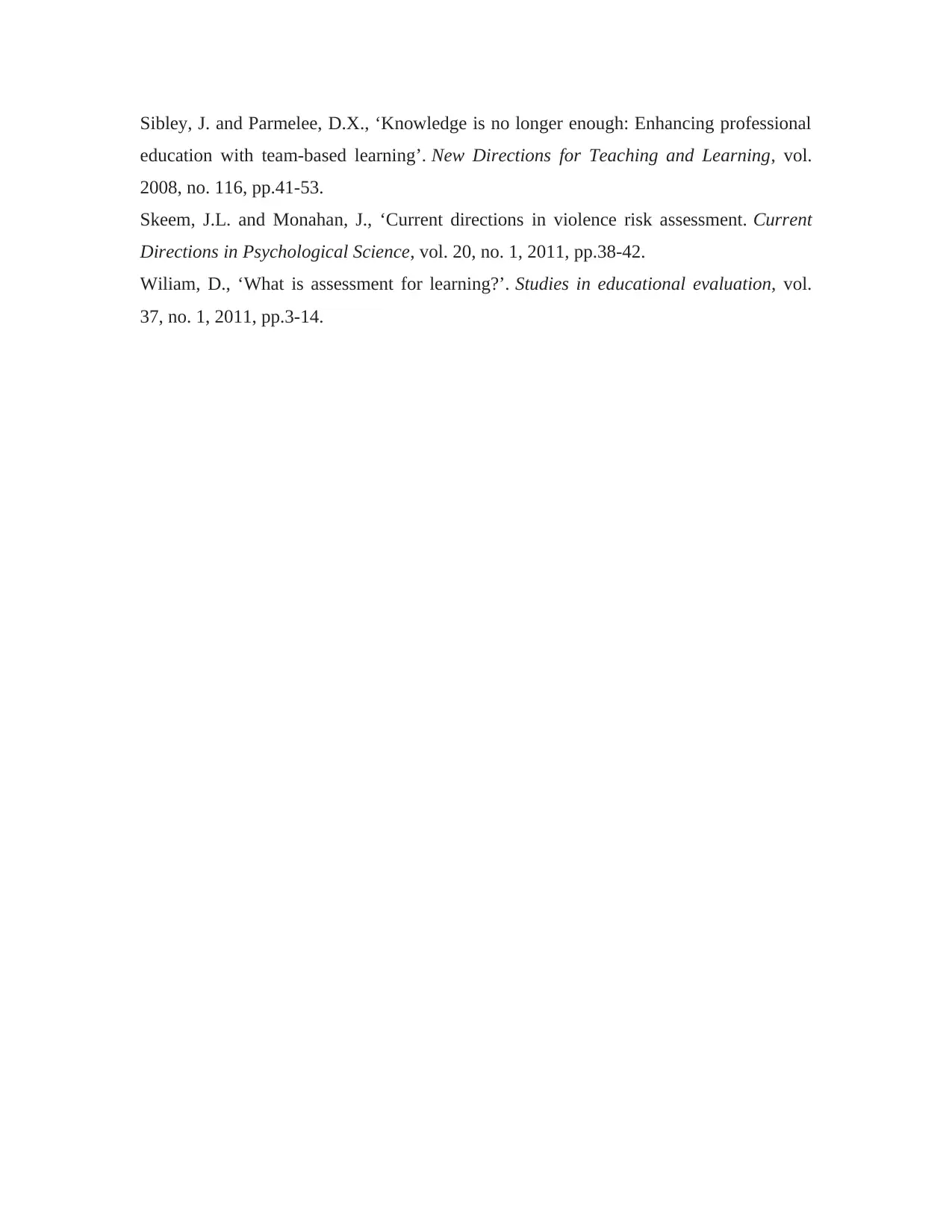
Sibley, J. and Parmelee, D.X., ‘Knowledge is no longer enough: Enhancing professional
education with team‐based learning’. New Directions for Teaching and Learning, vol.
2008, no. 116, pp.41-53.
Skeem, J.L. and Monahan, J., ‘Current directions in violence risk assessment. Current
Directions in Psychological Science, vol. 20, no. 1, 2011, pp.38-42.
Wiliam, D., ‘What is assessment for learning?’. Studies in educational evaluation, vol.
37, no. 1, 2011, pp.3-14.
education with team‐based learning’. New Directions for Teaching and Learning, vol.
2008, no. 116, pp.41-53.
Skeem, J.L. and Monahan, J., ‘Current directions in violence risk assessment. Current
Directions in Psychological Science, vol. 20, no. 1, 2011, pp.38-42.
Wiliam, D., ‘What is assessment for learning?’. Studies in educational evaluation, vol.
37, no. 1, 2011, pp.3-14.
1 out of 10
Related Documents
Your All-in-One AI-Powered Toolkit for Academic Success.
+13062052269
info@desklib.com
Available 24*7 on WhatsApp / Email
![[object Object]](/_next/static/media/star-bottom.7253800d.svg)
Unlock your academic potential
Copyright © 2020–2025 A2Z Services. All Rights Reserved. Developed and managed by ZUCOL.




